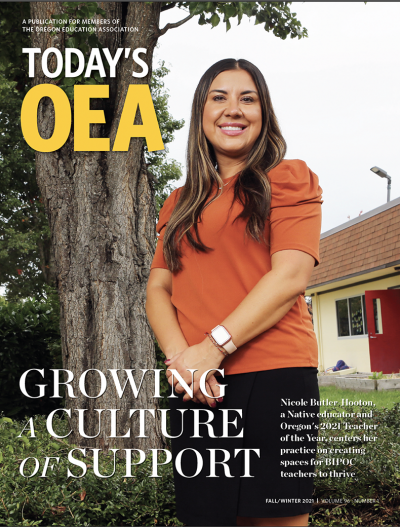In public schools in Oregon and throughout the United States, students in civics classes learn about one of the most celebrated cornerstones of our nation’s democracy: the peaceful transition of power. On Jan. 6, in Salem and in Washington D.C., we saw violent rioters attack this fundamental value as they tried, unsuccessfully, to disrupt the certification of votes of the electoral college. These actions will have far-reaching consequences for our nation, for our democracy, and for all our public institutions – including our public schools.
OEA joins with the multitude of public officials and organizations from both sides of the political aisle in categorically condemning these attempts to subvert our nation’s democracy. While the siege on the capitol shows the many weak points that exist in our nation’s democratic scaffolding, and how individuals might be able to exploit those weaknesses for their own destructive agendas, we, as a union, believe our institutions are strong enough to withstand these attacks.
To our educators who are grappling with how to facilitate conversations about these events with students in their classrooms, the Oregon Social Studies Task Force has compiled a useful list of resources for beginning and continuing this journey of reflection.
Included here are some resources that you may find helpful over the next few days and weeks.
- Creating Civic Spaces in Troubling Times
- ADL-Discussing Political Violence and Extremism with Students
- Mikva-Attack on Capitol
- Dr. Alyssa Hadley-Dunn Teaching the Days After
- Newseum- Front Pages From Around the Country
- Teaching Tolerance-Civic Disobedience
- PBS-Structured Academic Controversy
- Fostering Civil Discourse: How Do We Talk About Issues That Matter
- Fostering Civil Discourse: A Guide for Classroom Conversations.
- Teaching About Controversial or Difficult Issues
- Civil Discourse in the Classroom
An article from NEA Today, Talking to Kids About the Attack on the Capitol, also explores some key takeaways from these seditious attacks:
- Wednesday’s violence at the U.S. Capitol is an attack on our country and on our democratic institutions.
- Most children are aware of more than we realize, and many educators and parents have spoken frankly to them about the racism and bigotry that they have experienced or witnessed.
- Continuing that discussion is critically important in this moment.
“We must come together — just as we did in record numbers in the election — to show our students that we will stand together against politicians who incite violence and those who act on it,” said NEA President Becky Pringle. “We will stand up to those who empower the militants that have violently stormed the Capitol, trying to overturn the will of the people. We will protect our democracy. The world is watching. Our students are watching.”
— Becky Pringle, NEA President
Teaching in the Days After
A beautifully written guest post by Dr. Alyssa Hadley-Dunn, Associate Professor of Teacher Education at Michigan State University and founder of Teaching on the Days After: Dialogue & Resources for Educating Toward Justice also offers some thoughtful take-aways for educators to use in the classroom.
In her post on Beyond the Spotlight, Dr. Hadley-Dunn reminds us:
- Days After Pedagogy doesn’t mean turning trauma into a standard or a benchmarked lesson. But if you’re going to TALK about it, do so with intention, care, and an explicit commitment to justice and equity.
- Do not do this if you are going to cause more harm or trauma. Do not center images of Black suffering and pain as a way to make this a “teachable” moment. White teachers, this means you/us.
- And please, remember that this is not about a one-off lesson. Days After Pedagogy only works if you’ve been teaching for justice on Days Before and Days During.
Read Dr. Hadley-Dunn's full guest post here.
We're Here to Help. Please don't hesitate to reach out to your union for further support. Email us or connect with us on social media.

